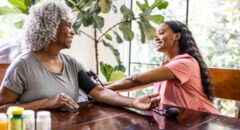
#WeSeeYou is BlackDoctor.org's weekly series aimed at shedding light on those who are doing something amazing that needs to be shown to the world. This week, we highlight Tiffany.
Let's be honest. When you think of someone who is an aerospace engineer, you think they would be mainly white, older and possibly even a little socially awkward.
Well, when Georgia Tech student, Tiffany proudly posted that she is will be graduating and going on to be an aerospace engineer, the internet took off.
“When I was 11, I asked for a circuit board for Christmas because I thought it was cool that this board could play such a huge role in how something works,” Davis said. “What can I say? I was just one of those engineering nerds. I still have that circuit board. It’s still really cool.”
MUST READ: Woman Born With No Legs Becomes A Lingerie Model
With nearly 12,000 likes and over 8,500 retweets, people seem to gravitate toward this talented beauty.
This is what an Aerospace Engineer looks like. #YesImARocketScientist #BlackGirlMagic #GTAE #33Days ???????? pic.twitter.com/Yy635rt2SK
— Tiffany Nicole (@TiffSaid) April 4, 2016
And people should be excited. The number of African Americans entering the Aerospace Engineering field is quite low (1 in tens of thousands), but those who have entered have done great work.
African Americans have contributed to other aspects of space exploration, including the implementation of satellites. Linda Gainer was a member of Chrysler's Saturn 1B launch crew. The Saturn 1B launched the Apollo 7 into orbit, which would become the first manned Apollo launch. Carole Ann Johnson, a thermodynamics engineer, contributed to the Atlas Missile and the Centaur Space Vehicle at General Dynamics. The Atlas Centaur was the prime vehicle for unmanned deep space missions; it also was used to launch Mariner 9 in 1971, the first satellite to orbit Mars. Another aerospace engineer is Raymond L. Coleman, weather-planet engineer. Coleman was a part of the team that designed, manufactured, and inspected the converters used to power the Nimbus A weather satellite. The Nimbus A was the first satellite to survey the entire earth's surface on a daily basis.
The U.S. military has also benefitted from the contributions of African-American engineers. O.S. Williams created the first......airborne radar beacon for recovering lost aircraft. With an aeronautical engineering degree, Williams also led the development of the lunar lander's guidance rocket engines. Also recognized is Dr. Wesley L. Harris. Harris, who received his aeronautical engineering degree from the University of Virginia and his Ph.D. from Princeton University, is renowned for his research in helicopter rotor aero-acoustics and unsteady transonic flows, research aimed at the reduction of helicopter noise. Dr. Harris was honored as a Fellow of the American Institute of Aeronautics and Astronautics in 1992 for his work in these areas.
Congrats Tiffany and to all the graduates of 2016!








